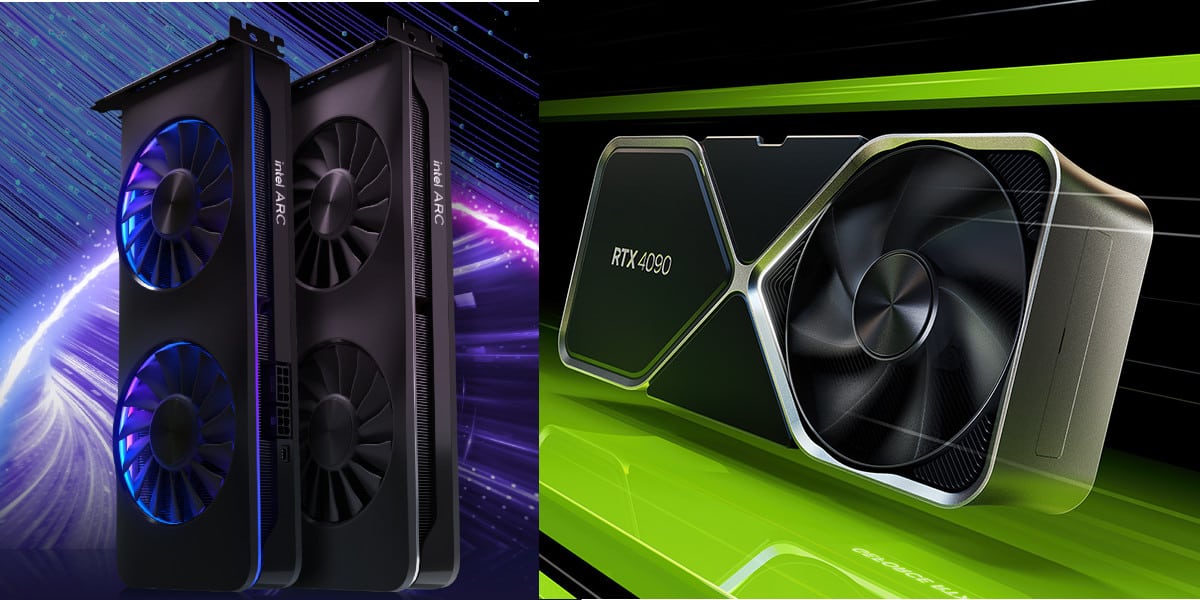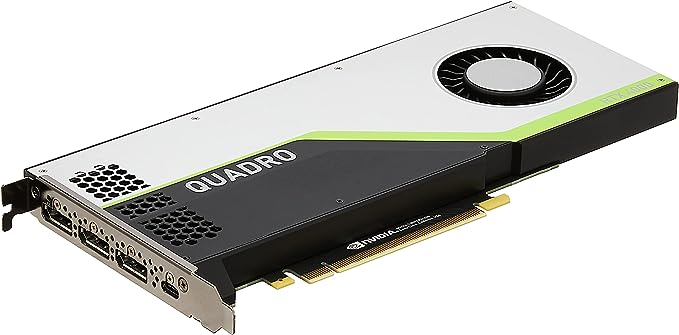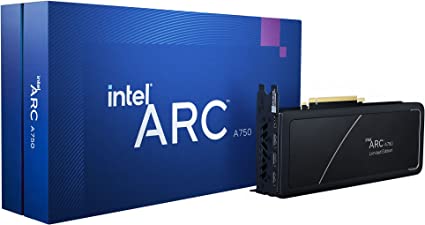Nvidia RTX 4000 vs Intel Arc: which GPU is right for you?

Table of Contents
The graphics card market is the most varied it has ever been. If you’ve been on the fence about RTX 4000 vs Intel Arc, we’re bringing you all the information you need to know ahead of these much-anticipated GPU lines. We’re comparing the price, performance, and availability to help you make an informed decision about which is right for you.
Until very recently the best graphics card space was dominated by two names, AMD and Nvidia. Enter Intel, best known as the manufacturer of some of the best CPUs for gaming, and team blue has finally emerged onto the scene. It’s not the company’s first foray into the field of dedicated video cards, but it is the first time that discrete desktop graphics have actually arrived.
Prime Day is finally here! Find all the biggest tech and PC deals below.
- Sapphire 11348-03-20G Pulse AMD Radeon™ RX 9070 XT Was $779 Now $739
- AMD Ryzen 7 7800X3D 8-Core, 16-Thread Desktop Processor Was $449 Now $341
- ASUS RTX™ 5060 OC Edition Graphics Card Was $379 Now $339
- LG 77-Inch Class OLED evo AI 4K C5 Series Smart TV Was $3,696 Now $2,796
- Intel® Core™ i7-14700K New Gaming Desktop Was $320.99 Now $274
- Lexar 2TB NM1090 w/HeatSink SSD PCIe Gen5x4 NVMe M.2 Was $281.97 Now $214.98
- Apple Watch Series 10 GPS + Cellular 42mm case Smartwatch Was $499.99 Now $379.99
- ASUS ROG Strix G16 (2025) 16" FHD, RTX 5060 gaming laptop Was $1,499.99 Now $1,274.99
- Apple iPad mini (A17 Pro): Apple Intelligence Was $499.99 Now $379.99
*Prices and savings subject to change. Click through to get the current prices.
With that said, what makes the battle of RTX 4000 vs Intel Arc the most interesting is that both hardware brands are taking completely different approaches. The former is storming out the gate all guns blazing with the bleeding edge and the latter is targeting wallet-conscious consumers. Here’s everything you need to know about how the two GPU generations compare.
Nvidia RTX 4000 vs Intel Arc: Price comparison
If you’re going from purely a value perspective in the battle between RTX 4000 and Intel Arc then the latter takes the victory. The current lowest-end GPU in the company’s lineup, the A380, comes in with an MSRP of just $139.99. That’s significantly cheaper than anything Nvidia has on offer right now from either Ampere or Ada by over $100.
If we take the highest-end Arc graphics cards into account, the A750 and A770, both GPUs carry a starting MSRP of $329 and $349 respectively. As a frame of reference, the closest possible Nvidia equivalent, the RTX 3060, begins at $329. What does this mean for you? The best value for money, at least on paper, appears to be with Intel’s line of limited-edition video cards.
In contrast, the RTX 4000 series was formally unveiled to launch with two distinct high-end models, RTX 4090 and RTX 4080. The latter is available in two different memory configurations, 12GB and 16GB GDDR6 VRAM. The newest flagship model will hit shelves both physically and virtually for $1,599. The RTX 4080 variants will retail starting at $899 (12GB) and $1,199 (16GB).
In essence, we’re effectively getting an RTX 4070 in all but name with the cheaper RTX 4080 GPU in the lineup. The prices are admittedly higher than what we saw with the Ampere line, roughly $100 more expensive with Ada. There’s currently no real middle ground to speak of here. You’re either opting into market-leading performance at a premium or staying on budget.
Nvidia RTX 4000 vs Intel Arc: How do the graphics cards compare?
Knowing the specs for both RTX 4000 and Intel Arc is a good way of knowing which card is right for you. Below, we’ve compiled a full easy-to-read table of how both video card generations contrast against each other.
| VS | Nvidia RTX 4000 | Intel Arc A-series |
| Graphics Procesor | AD102 | DG2-512 |
| GPU cores | Up to 16384 | Up to 4096 |
| Memory type | GDDR6X | GDDR6 |
| VRAM | Up to 24GB | Up to 16GB |
| Memory clock speed | 2235 MHz | 2100 MHz |
| Bandwidth | Up to 1,018 GB/s | Up to 560 GB/s |
| Memory bus width | 384-bit | 256-bit |
| Price range | $899 – $1,599 | $139 – $349 |
The specs sheet here compares the highest end of both options so you’ve got the full picture. As is evident, the pricing varies wildly between what Ada is capable of when stacked up to the first generation Xe GPUs. As for how this impacts performance, we’ve touched upon this below.


Nvidia RTX 4000 vs Intel Arc: Performance
It should be unsurprising that the top-end RTX 4000 graphics cards outperform what Intel Arc can do. The two video card lines have entirely different audiences after all. With the review embargo now lifted for the latter, we’re now aware of just how capable the Arc A-series is from a budget perspective.
According to sources who have had hands-on experience with the Intel Arc A770 graphics card, the GPU roughly performs as well as the RTX 3060 in demanding titles. According to reviews, such as those published by The Verge, the A770 16GB is a decent performing card for 1080p.
Such titles that were benched include Microsoft Flight Simulator, Metro Exodus, and Cyberpunk 2077 at ultra settings. The A770 performed well, generally hovering around the 60 FPS mark in Full HD. In some instances, the card was outperforming the RTX 3060 Ti as well.
The real highlight of the Intel Arc A770 line appears to be its XeSS (supersampling) performance. According to the XDA Developers review, the GPI shined much brighter with dedicated performance and ultra settings modes. Highlights included Death Stranding Directors Cut, Hitman 3, and Ghostwire Tokyo pushing 100 FPS in 1440p with ray tracing enabled.

For this, we can discern that the Intel Arc series of graphics cards do perform well, but they’re not quite the giant slaying titans of industry that some people may have hoped for. This is in stark contrast to what’s been published regarding the RTX 4000 series, with a far higher price tag bringing with it leading performance across the board.

As for the RTX 4000 series, we’ve not had many real-world benchmarks. Published by Nvidia, we’ve got a proper look at the theoretical performance of the RTX 4090 against the previous BFGPU. As you can see, there’s roughly double the performance in Microsoft Flight Simulator and Warhammer 40K: Darktide, with Cyberpunk 2077 benefitting the most heavily from Ada.
Now, the RTX 4090 is targeted at more than just gamers. It’s being marketed on its prowess for creators as well. That doesn’t change the fact that ray tracing continues to be an incredibly hardware-intensive task for the real-time lighting rendering technique. Now, with the third generation of RTX, high framerates and higher resolutions could be more on par.
When will RTX 4000 and Intel Arc graphics cards be released?
Both the RTX 4000 series and Intel Arc graphics cards are scheduled to release on October 12. More specifically, the RTX 4090 from Nvidia will be available on this date, with the Arc A750 and A770 hitting the shelves then, too. As for the RTX 4080, both variants are set to come out in November, and the Arc A580 is yet to be determined.
What is a Resizable Bar for Intel Arc?
The ReBar, or the Resizable Bar, is a motherboard setting that allows more computational data to be delivered between the GPU and your CPU. As a result, you’ll need a newer processor to take advantage of this feature. Intel has stated that everything from its 10th Gen is supported. ‘Most’ Ryzen processors upwards of 3000 series should be compatible, too.
Will there be RTX 4000 and Intel Arc stock available on launch day?
If you cast your mind back to the troubled launch of the RTX 30 series then you’re right to be skeptical about availability. However, in late 2022, the graphics card market appears to be in a much healthier place. We cannot guarantee that there will be a surplus of RTX 4090 and Intel Arc A770 stock hitting shelves, but things are more encouraging than two years ago.



